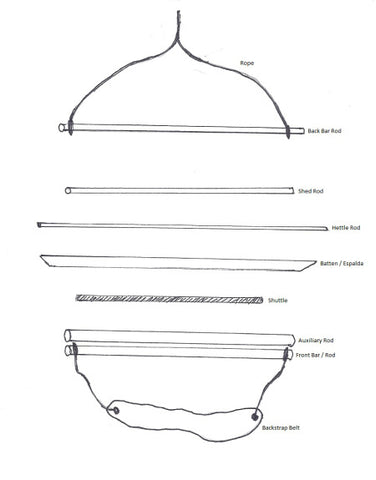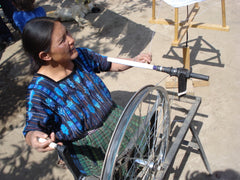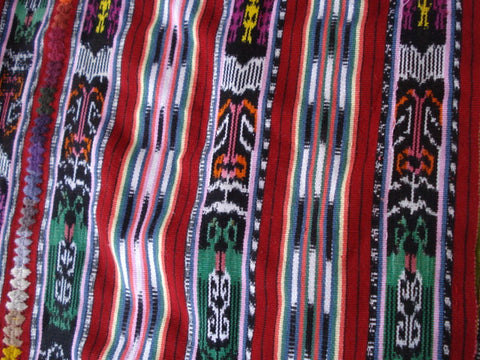Preserving the culture and traditions of artisans is an important aspect of Fair Trade. One of the traditions in the Mayan villages of Guatemala is that of backstrap weaving, a form of weaving which is known to have been practiced since about 2500 BC in the Americas. Many examples of early woven textiles have been found and preserved from the regions of South and Central America. The looms have changed very little through the centuries.
Typically made of 7 rods, these looms can be set up easily in small spaces in the home and doesn’t need an entire room like a large foot pedal floor loom. It can be rolled up and set in a corner between weaving sessions. Weaving on a backstrap loom in Guatemala is traditionally done by women and although Mayan women weave textiles for their own home use, many weave items to sell to the tourist markets in the larger cities.
A backstrap weaving loom is a primitive set up of just 6-8 sticks/rods and a backstrap belt with rope to tie the loom to a post or tree. Many girls living in the rural areas where traditional ways are strong are still being taught to weave. However, it is becoming a lost art among the younger women in the larger cities of Guatemala.
The drawing below shows a typical loom set up by the Mayan women in Guatemala, however the set up can vary from village to village just like the designs and colors of the textiles vary.

Most weavers in the rural western areas of Guatemala still use very simple tools to prep and warp the yarn. A yarn winder is usually handcrafted of local wood and at times an old bicycle wheel is recycled into a yarn winder which will make winding yarn a little more efficient. The warping board is also handcrafted of wood and is used to design the pattern of colors and stripes wanted in the weaving. Most warping boards are 5-6 feet long and if there are no legs on the board it is simply laid on the ground.


The maximum width of woven fabric from a backstrap loom is approximately 26 inches but if wider cloths are needed, then two pieces are joined together with decorative stitching. These wider cloths can then be used for blankets and table cloths.
Many Fair Trade organizations work directly with artisans and incorporate their traditions and culture in product development. Being cognizant of those traditions and the heritage when new designs are implemented is a leading factor for Fair Trade companies. Every time a backstrap loomed textile is sold it helps the artisan earn a fair wage and share her heritage with people around the world.
Following are some photos of fabric that was woven in the traditional Mayan way on a backstrap loom.




For More Information:
Backstrap woven products can be seen here.
Learn to weave on a backstrap loom with Mayan women on a tour to Guatemala.
Casa del Tejido Antigua - Weaving Museum in Antigua, Guatemala - to learn more about the culture and weaving but also see photos of the typical dress of the Mayans
Look for these books online for more information on this style of weaving:
- Techniques of Guatemalan Weaving by Lena Bjerregaard, 1977 - One of the best books on backstrap weaving in Guatemala.
- Backstrap Weaving by Barbara Taber and Marilyn Anderson, 1975 - A very comprehensive book about backstrap weaving. Look online for used books.
- The Weaving Primer by Nina Holland, 1978 -A complete guide to Backstrap, Inkle and Frame Looms. Look online for used books.
- Weaving Generations Together, Evolving Creativity in the Maya of Chiapas, by Patricia Marks Greenfield, 2004


